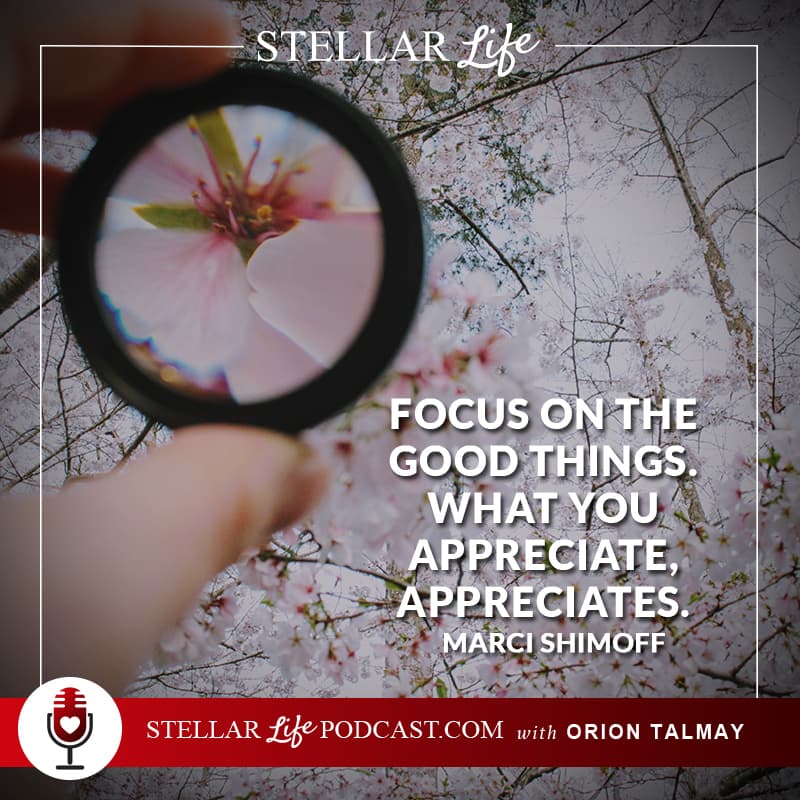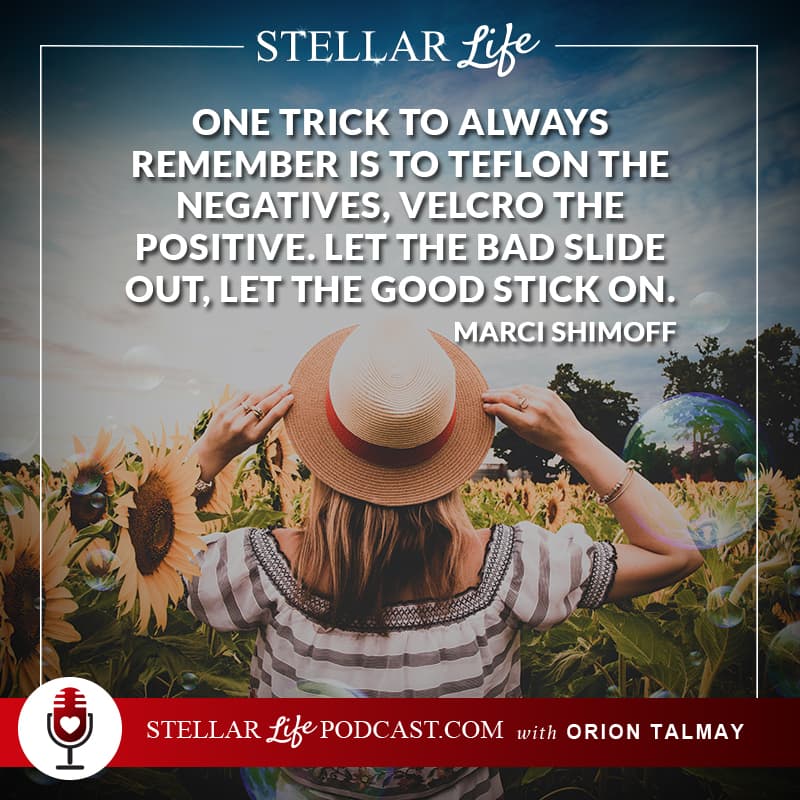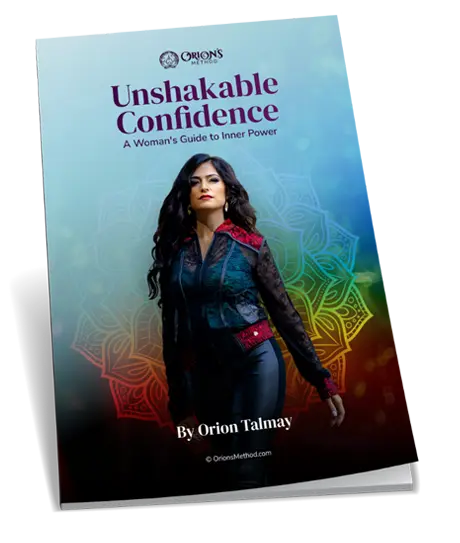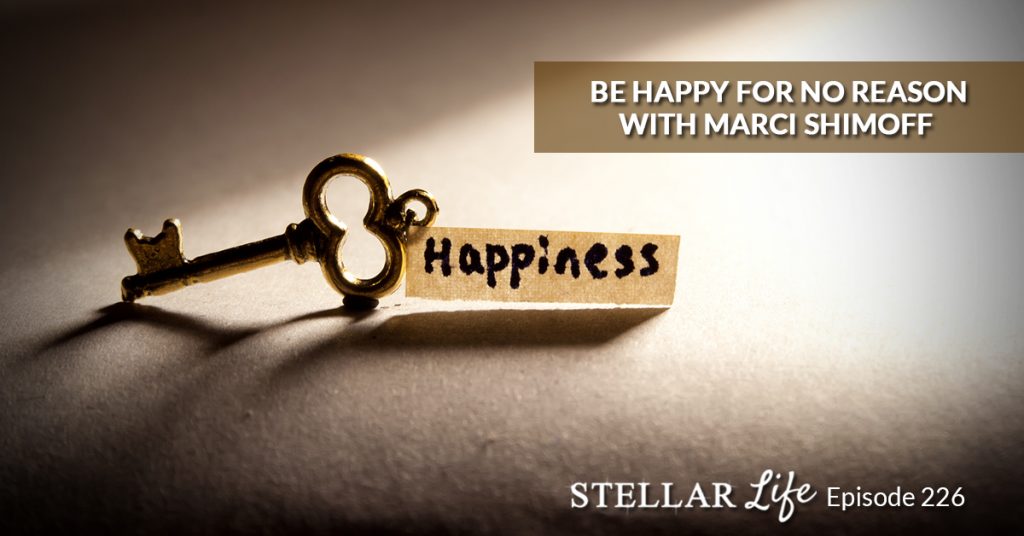
In this Episode
- [00:49] Orion introduces Marci Shimoff, #1 NY Times bestselling author, a world-renowned transformational teacher, and an expert on happiness, success, and unconditional love.
- [03:18] Marci shares her turning point moment on discovering her passion for helping people find happiness.
- [07:45] What is a happiness set-point?
- [12:36] Orion describes the three things that she appreciates in her surroundings while sitting at her desk.
- [16:01] Marci shares the three steps on how to Velcro the positives to be happier.
- [20:13] Marci shares the seven main categories of happiness habits, where she created a metaphor for people to remember easily and practice.
- [24:50] Orion shares her weakest area out of the seven main categories of happiness.
- [30:15] Orion explains the impact of people you surround yourself with to your happiness
- [34:42] Marci and Orion perform a simple exercise that can shift your mood and emotion in less than two minutes.
- [38:39] Visit Marci Shimoff’s website happyfornoreason.com to get your free Happy for No Reason workbook and to learn more about happiness habits.
About Today’s Show
Hi, Marci, and welcome to Stellar Life Podcast. It’s a pleasure having you here.
Orion, I’m so happy for a great reason to get to be here with you today. I know we’re gonna have a fabulous conversation.
Thank you. I’ve been following you, I’ve been listening to your stuff, and you’re incredible. I’m sure that every one that is going to tune in and watch this video is gonna be so much better at the end.
Well, that’s our intention. We’re setting that as the intention.
So before we start, can you share a little bit about how you came to this passion of helping people with finding happiness, self-love, and all that good stuff?
I am the least likely person in the world to be speaking and teaching about happiness and unconditional happiness because I was born depressed. I joke with people that I came out of the womb with existential angst. I had a great family, great parents. All was well, but I felt as though I had this kind of dark cloud around me. I felt like I was carrying some heavy burden in my heart. I think I’m an empath. I think a lot of people who are empaths, they can relate to that. So I grew up really unhappy, and sugar was my medicine, I became a sugar addict. By the time I was a teenager, I was about 35 pounds overweight, which made me even more depressed. So when I was in my 20s, I figured that I got to handle this, and I want to be happy.
So I did what most people do when they want to get happy, I set goals for myself. And I figured that once I reached those goals, then I’d be happy. And I’ll share with you what those goals were because I think a lot of people will be able to relate to this. I had five, and I wanted to have a successful career helping people. I wanted to have a wonderful husband or life partner, great friends, a comfortable home, and the equivalent of Halle Berry‘s body. Now, I got four out of the five. I don’t have Halle Berry’s body, but I have a healthy body for which I’m very grateful. And I will tell you, I worked really hard to get all my ducks in a row so that I could be happy. I worked so hard on this, and finally, I had it. I really had it all, and I had a turning point moment.
Happiness is 10% circumstances, 50% genetics, and 40% habits. We can't change circumstances but we can shift our genetics and behavior. You actually control 90% of your happiness. Share on XIt was in 1998, I had three books in the top five on the New York Times bestseller list all at the same time. And I had just finished giving a speech to 8000 people, and I autographed 5432 books. I felt like an author rock star. And after I autographed that last book, I went up to my hotel room. It was in Chicago, and it had this huge, beautiful view, these big windows viewing over out onto Lake Michigan. And I literally felt like I was on top of the world physically. I went over to the window, and I took in that beauty. I turned around, and I fell onto the bed, and I burst into tears. And I burst into tears because I realized I had worked so hard my whole life to get what I thought I needed to be happy, and I still wasn’t. I realized that I could no longer fool myself into thinking that just the next thing was going to make me happy. And so I still felt that deep emptiness and depression inside that I’ve had in my heart from childhood.
So I took a lot of time to dive into the subject of happiness, and I interviewed all of the researchers in the field of positive psychology and happiness. And I interviewed 100, what I call unconditionally happy people. And I started doing what they were doing, and it worked. I would say back then, if you were giving me a grade in happiness, I would have gotten a D+, I was almost failing in happiness. Now, I am a solid A, and that doesn’t mean that I’m not still working on it, I am a work in progress. I think we’re working in progress for the rest of our lives. But it means that it’s solid. And even when stuff goes on, like stuff going on in the world, like what we have now, there’s still this feeling of deep inner happiness that I carry with me. So what I found is that this is possible for anybody, and I’m passionate about this. I’m passionate about sharing it. I know that we’re going to get into some really practical things today that people can do to be happier immediately.
Right. What was the most surprising thing that you found talking to all these people? Did you find something in common?
I found out a couple of things that really made sense to me. The first one that to me, out of all the research, it was like the light bulb went off in my head. And it was that we all have a happiness set-point. And it’s like a thermostat setting. No matter what happens, whether it’s good or bad, we’re going to hover around this thermostat setting, unless we do something consciously to change that. And this explained a lot to me. This explains why there are some people that are born happy; they just have a high happiness set-point. And I wasn’t one of those people. And no matter what I would do to get happy, I’d be happy for a little while, but then I would soon return to my original happiness set-point.
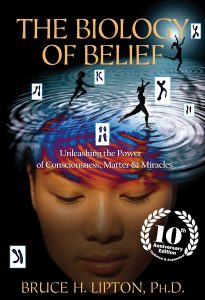
I saw that it’s that set-point that’s really the key to happiness. And so you probably wonder, what is the set-point made up? Let me just tell you about that because that was the eye-opening piece. The set-point is only 10% of our circumstances. That’s why going after changing anything in life is only going to give us a temporary high. I mean even people who win the lottery. You don’t think, “All I have to do is win the lottery, and I’d be happier.” No. You’d be happy for a little while, but they found that people who win the lottery are back to their original happiness set-point within a year. So because it’s only 10% of our circumstances, 50% of it is our genetics. Now, I was not born with good genetics for happiness. But the other 40% is our habits of thoughts and behavior. And that’s what we can really do the most to change to raise our set-point. But I’m going to take this a step further and say there are scientists in the field of epigenetics like Dr. Bruce Lipton, who wrote The Biology of Belief.
I love him.
Isn’t he awesome? And he and many others will say that those genes, that 50% of genetic, can even be influenced when we change our habits of thoughts and behavior. So that means that 90% of our happiness set-point can be changed by changing some simple habits. I don’t know about you, but I think that should be headline news. That should be like; happiness is the thing we’ve all wanted forever. And we know how to get there, we know the habits of happy people. I just found out from you that you have a beautiful eight-month-old baby.
Yeah, he’s so cute.
A better thing to give a baby is to allow them to grow up with a high happiness set-point.
Yeah, so I just had a conversation with my client. And I found out that regardless of the amazing things that she achieved in her life, she never stopped to celebrate. She doesn’t celebrate the small moments of achievements. She doesn’t celebrate the big moments of achievements. She said, “I’m afraid I might jinx it.” So she walks through life without even giving herself that moment of happiness, that moment of like, “I did it,” that moment of reassurance. And because there are so many people that have the house, the car, the trophy wife, and still they don’t stop to smell the roses. And I believe that acknowledging every moment, instead of like, “I’m going to be happy when I’m going to have this and that.” This is not the way. Happiness is the way, it’s not the goal to happiness that will make you happy. It’s the way to happiness and steps in to smell the roses, which is something that I do with my baby. We have roses outside, and we stop, and we smell the roses.
I love what you’re saying. It is absolutely 100% true, everything you said, we have this myth of happiness. And it’s exactly what you said it’s the “I’ll Be Happy When” syndrome. I’ll be happy when I get a better job or when I make more money. And then those things happen, and we’re happier for a short period of time, but it doesn’t last. And it doesn’t last because it doesn’t raise our set-point and we can’t even receive or appreciate what we currently have. That principle of appreciating, savoring, and taking in what we currently have is so important. There’s a saying that what you appreciate, appreciates what you appreciate, grows stronger in your life. I mean right now in this very second, we all have so many things we could appreciate. And I would love for everybody just this moment right now, Just look around you, and just feel into you. And find three things right now that you can deeply appreciate. I’ll tell you right now what I appreciate. I am looking out at the most beautiful trees; they’re fabulous. I appreciate that I’m getting to have this conversation with you, that’s about something that I’m so passionate about. And I appreciate that I feel good in my body right now. So everybody can find three things. Can you find three things right now?

Oh, I found like a million. The first thing I saw was your image, I mean on the video, and I was really appreciative of you and your wisdom and having this conversation with you. And the beautiful flowers behind you, this background and it makes me happy to see this image with all the pink and green colors and your radiant energy. It makes me happy, so I appreciate that. I appreciate my mic; it’s pretty cool.
Yeah, you got a really cool microphone.
Everything, being able to be here and sitting on this nice desk looking at the windows and the tree, everything. I love it.
Can I explain why this matters and why this works because it sounds so simplistic? Everybody talks about all of this, but let me talk about why this works the way that it does. The average person has 60,000 thoughts a day. And for the average person, 80% of those thoughts are negative. It’s called the negativity bias. We inherited it from our caveman ancestors who needed to really focus on the negatives, or they would die. But we no longer have that tendency, the way that they
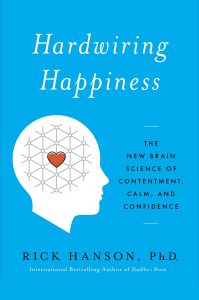
needed it back then. And yet we haven’t really caught up to changing our brains. Rick Hanson, a friend of mine who wrote the Hardwiring Happiness, calls it the Velcro Teflon Syndrome. He says that our minds are like Velcro for the negative, the negatives just stick to us, and they’re like Teflon for the positive, the positives slide right off of us. Now, what we’ve found is that happier people have reversed that tendency. They have found ways to Teflon the negative, let those go, and velcro the positives. And what that does is it creates new neural pathways in the brain for the positives. Now, let me give you an example. And then I’m going to tell you how you do that very simple three steps. Let me just ask you this, well, you might have actually learned better, but perhaps the earlier version of you, if you get ten compliments and one criticism in a day, what do you tend to remember?
The one criticism still, even though in my mind, I know that I should remember the accolades or the compliments.
Right.
But what goes in is, “Oh, they said something wrong. Somebody said something wrong about me.” But like now, it’s way better than in my 20s because awareness and knowledge is power and implemented knowledge is even more power. And still, sometimes, this is true to this day.
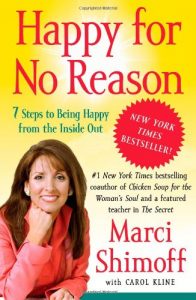
I use that example because it’s a tendency we all go to is believing the negative, letting that stick, and sort of sloughing off the positive, happy people do the opposite. So here’s what the brain researchers have said about how to velcro the positives. There are three steps. Number one, be on the lookout for them. We’ve got to be on the lookout for the positive. One of the women I interviewed in my book, Happy for No Reason, pretends that she’s the Academy Awards committee, and her job every day is to give out five Academy Awards. So she’s always on the lookout, like “What’s worthy of an Academy Award today?” So she’ll be walking down the street, and she’ll see a cute little fluffy white dog, and she’ll think that dog gets the cutest dog of the day award. So if you have children play this with them as a game to be on the lookout for the positive. So that’s step number one.
Step number two is very important, savor the positives. And what that means is that it takes 20 seconds to take in the positives deeply enough to create new neural pathways in the brain. So you can’t just notice something and go, “Okay, that’s a cute dog” and walk away. Or, “Okay, that’s a beautiful sunset” and walk away. You need to be with that experience and even feel it in your body. Savor it like you’re taking in this delicious dessert for 20 seconds or longer. So if you do see this cute little dog, you might go up to the owner, and you might say, of course, these days being six feet socially distanced from them, you might go up to the owner and say, “Oh, that dog is the cutest dog. I give out these Academy Awards every day, and your dog gets the Academy Award for being the cutest dog of the day.” And you take it into your heart, and you let it settle in your body, rather than just notice it and run away. What we want to do is we want to get in the habit of savoring the good for at least 20 seconds, so that’s the second step. First is notice, second is savor, and the third step is to go for what we call the 3:1 ratio, three positives to every one negative.
I heard it was 5:1.
Yeah, good for you, man, you are on this. There are different statistics, and what I find is 5:1 is ideal, but it’s a little hard to start there. So I tend to start people a little bit more easily with 3:1. So if you had one negative, switch it over, focus on three positives. When it comes to relationships, the research in relationships shows that you need five positives in a relationship to every one negative. So that means if you’re being negative with your partner, then you’ve got to replace it with five.
It’s almost like people don’t hear it. When you say, “Oh, you’re beautiful.” Like, “you’re beautiful.” “No.” “No, you really are so beautiful. You are beautiful.” “Oh, thank you.”
You need to really be in the habit of taking it in because what happens when you have neural pathways established in the brain for the negative, that’s what you tend to see. We notice what we’re looking for and what we put our attention on.
What is it called? Activated system something.
Reticular activating system.
Yeah, a reticular activating system.
Thank you.
No, thank you.
Together we can come up with that.
Focus on the good things. What you appreciate, appreciates. Share on XYeah. So if you’re looking for the color red, you’ll see it everywhere. If you look for BMW, you’ll see the same car everywhere. As soon as you put your attention into something, you’re gonna start seeing it because your brain will lock on that. Because we are bombarded with so much information, your brain is sifting and sorting through your habits and your values. So if you focus on happiness, if you focus on the Academy Awards, you’re going to start seeing them, you’re going to start noticing them. And then like you said, the path of happiness in the brain is going to open, and instead of being sad, depressed, stressed as a default, which are valid emotions, we all need to feel your default will become the path of happiness.
Yes, you are spot on with all of this. Now I want to say something, though. I think that there’s a concept out there that all you have to do is change your thoughts, and then you can be happy just to decide to be happy. And what I found is that that’s not exactly true. When I interviewed all these people on happiness, I found that there were 21 main happiness habits that people practice, and they fell into seven main categories. And you could have one of those categories really working well for you or many of them. But what if one of them isn’t working well, then it’s going to really impact your happiness. Shall I go through what these seven areas are?
Yes.
Okay. I found that it’s hard for people to remember seven of anything, so I created an analogy or a metaphor. I call it building your inner home for happiness. And a home has seven main components to it. It’s got a foundation, it’s got four corner pillars, it’s got a roof, and it’s got a garden. And this is how it relates to these seven areas of happiness. And as I go through these, what I want everyone to do who’s listening is I want you to think to yourself, “Where am I the weakest?” Because wherever you’re the weakest, that’s where I’m going to suggest where you start to raise your happiness set-point because that’s where you’re going to get the most shift quickly. Here’s how these seven areas go. The foundation is about taking responsibility for your life and for your happiness.
So powerful.
So if you tend to be what I call a victim in life, and you know a victim when you are stuck in blaming, shaming or complaining—blaming other people, shaming, which means blaming yourself, feeling shame or embarrassment, and complaining. When you’re in any of those, you are in the victim mode, and it’s almost impossible to be happy. So that’s the first area. Then the four corner pillars are the pillars of the mind, the heart, the body, and the soul. The mind we just spoke about, do your thoughts support your happiness? The heart, do you live with an open heart? Do you have gratitude and love, forgiveness and generosity of spirit? Every happy person I’ve ever known has an open heart. Then there’s the body, do you have the biochemistry of happiness? Do you have enough serotonin and oxytocin and endorphins, the neurochemicals of happiness? And by the way, that’s where I was the weakest my whole life. And there are very specific things that you could do if you don’t have the biochemistry for happiness, you can shift. And then there’s the pillar of the soul. And the pillar of the soul is about our spirit. Do you feel connected to a greater energy in life? And it doesn’t matter what you call it, that could be God, the divine creative intelligence, nature, the one, doesn’t matter, it’s just a sense of, “Do you feel your spiritual connection to life?” Then, there’s the roof of your home for happiness, and that’s your inspiration, your purpose in life. Are you living your purpose? I believe we’re all here on the planet for a reason. Are you doing what it is you’re here to be doing? And then finally, there’s the garden. The garden has to do with who you surround yourself with. Are you surrounded with roses and gardenias? The people who support your happiness. Or are you surrounded with some weeds? Some people who are dragging down your happiness. And so those are the seven areas. And Orion, I’m going to ask you to be a guinea pig and share with us out of those seven areas where you think you’re the weakest?

Wow. I have to go through the garden and the roof and the pillars.
Okay, so the foundation is taking responsibility for your happiness.
Got that.
And then there’s the pillar of the mind, your thoughts. The pillar of the heart, living with an open heart. The pillar of the body, your biochemistry. The pillar of the soul, your spiritual connection. Your roof is your inspiration or passion in life, and then the garden is who you surround yourself with. So where do you think?
I think for me, it’s a little bit in biochemistry because since I gave birth, I mean, my pregnancy was very difficult. And I gave birth through a C-section and the recovery from the surgery and all that. Like, I used to be super strong in my body and very flexible, and then everything stopped. I used to train five times a week.
Wow.
Yeah, I did stuff like Tough Mudder and things like that. So I think for me, it’s connected more to my physical well being. I also used to do S Factor®, which is sensual movement and all that.
Yeah, I know S Factor®. My coaches were very involved and had an S Factor® thing going.
S Factor®, for people that don’t know, it’s pole dancing, but it’s connecting to your body and connecting to your feminine essence, and it’s more than just pole tricks. It’s almost like a feminine spiritual journey, if you may. So yeah, I used to do that, and I missed that, I missed moving my body. The C-section almost felt like it divided my body in two, like a curtain, like that metaphor. It took me a while because it was unexpected. I planned a beautiful water home birth, I had the team here, and I had a doctor, and it was amazing. And then I was in labor for 12 hours, and I was fully dilated and ready to go. And then boom, I had to go to the hospital. And it was also a lesson in manifestation. I was always really cocky and proud of myself for being able to manifest things, like, “I’m gonna manifest this the way it should be, this is how it’s going to work,” and it worked exactly the opposite. And I also knew that you need to look at the bigger picture and whatever my soul had to experience. However, this baby wanted to come to the world, and it’s his journey. There is a bigger force in all this, and now I can see it, but when I was in it, it was hard. And especially because I learned to be so connected to my body. Having this disconnection was hard on me, and I’m slowly getting into that movement, into that flow, into strengthening myself. I also have shoulder injuries and wrist injuries. So it really threw me off.
One trick to always remember is to Teflon the negatives, Velcro the positive. Let the bad slide out, let the good stick on. Share on XFor me, definitely biochemistry and mindset, even though I learned about mindset, and I teach mindset. With COVID-19 and everything that’s going on, I’m definitely into conspiracy theories that I believe some of them are not a conspiracy. And I’m worried about the future. I’m worried about where this country is heading. I’m worried about forced vaccinations. I’m worried about implanting a barcode or chip in our babies or even in ourselves. I’m worried about 5G, and I’m worried about those things. And I know I should not focus on them, but sometimes I go there and I think this can take away my happiness.
Thank you for sharing that. I appreciate you sharing that, and I can relate to the idea of thinking that I’ve spent too much of my life thinking that, “I should be the general manager of the universe. I know how this should go, and it should look like this.” You know there’s that joke about, tell God your plans, and God laughs or something. So here’s a really interesting thing I learned when I interviewed these happy people. They all believed that the universe was a benevolent universe. Einstein said that the most important question we can ask ourselves is, “Is this a friendly universe?” And that doesn’t mean that everything goes the way you want it to go or the way you think it should go. But what it means is that these happy people believe that the universe is on their side, that the universe wants for their highest and best good, that instead of being paranoid, you’re an inverse paranoid, that the universe is for me. And so happy people believe that. I always say to people that one of the questions I think is very valuable to ask is, “If this were happening for a higher purpose, what might that be?” For your situation where it didn’t go the way you wanted it to go. But if you truly believe that it’s a friendly, benevolent universe that’s on your side, then it happened for your highest good.
Yeah, I do believe that.
And we may not be able to see it at that time, and it’s easier to see it later on. But what I found is when people are, even right now, going through the pandemic that we’re in, I can’t answer why it’s happening for the planet. I do know that more has been done to reverse the ill effects of pollution in the last two months than has been done in the last 30 years. The planet is being restored. There are some really amazing resets happening. So I can’t know it for the planet, but I can ask that question for my own life. If this is happening right now for a particular reason to support me for a lesson or a gift in this, what might that be? And I would invite everybody to ask that question for themselves right now in their life.

Yeah, and I think that’s why the garden is so important, the people you surround yourself with. Because people like you, your loved ones, and people that have your best interest in heart may be awakened, and they will lift you up because sometimes we go down rabbit holes, sometimes we feel stressed and depressed. It’s hard not to for an empath, and it’s hard not to feel the heaviness and distress. It’s enough to go to the supermarket and see people like they’re scared.
Right, with their masks.
Or even down the street, I start talking to people down the street without any attachment to the consequences. Like if they’re afraid, they’re afraid, but lately, more people are trying to connect because I think it’s really important to connect. That social distancing is a bad word, physical distancing, not social.
And what I’ve seen is that there’s that, and there’s also so much deeper connection. I think it’s really bringing people together. When I go on a physically properly distance hike, which I do regularly, I see all kinds of people out that wouldn’t normally be hiking. And there’s just this unity, this connection. And can I share one thing, though, that people can do if they feel that they don’t have the neurochemistry of happiness?
Even more than that, as much as you want to share. Please, this is important.
Okay. So serotonin is the happiness chemical. That is one of the most important happiness chemicals, serotonin. If you crave a lot of sugar, like I did, it’s because you’re probably because you’re low in serotonin. There is a very simple way to raise your serotonin. And I learned this from a Qigong master, whose name is Gil Morin. And it also will help you with your sleep. So it’s good for everybody, and it doesn’t take much time. It’s called sunning meditation. Now, people freak out when they hear sunning meditation. Don’t worry, you’re not going to be in the sun for more than about three minutes. So here’s what you do, three minutes, twice a day, you go outside into the sun. And if there’s no sun, if there are clouds, there’s a little bit of sun coming through the clouds, that’s okay, too. If it’s raining, I’ll tell you what else you can do instead. But you go outside, and you stand facing the sun with your eyes closed. This is super important; you close your eyes, and with your eyes closed, You let the sunlight come in through your closed eyelids, and nourish and feed your pineal gland. Your pineal gland is in the center of your head behind the optic nerve. And what it will do is it will start stimulating more serotonin in your body. You just do that for about three minutes, just feel as though you are soaking in that life force from the sun and that it’s feeding your pineal gland. If you do that twice a day for one week, it will raise your happiness set-point, it will raise your serotonin, and that will shift your happiness set-point.
That’s amazing.
Something that simple but make sure you’re hearing me, your eyes are closed as you’re facing the sun. And if there is no sun out, you can just look at something very beautiful. Beauty will also create a similar experience, natural beauty. Look at a tree or a flower, but it is more or less ideal if you can do it with the sun.
Five minutes of us being angry or upset can weaken our immune system. Whereas five minutes of us feeling grateful and joyful will strengthen us. Share on XThat’s beautiful. Can you also take us through an exercise, you taught this on one of the podcasts that I listened to, where you put your hand on your heart?
Yes, I’d love to share that.
Yes, please.
This is an exercise that I learned from HeartMath Institute. They’re the world’s leading researchers in the heart and happiness, and they found that five minutes of us being angry or upset can weaken our immune systems for up to six hours. Whereas five minutes of us feeling grateful and joyful and loving, will strengthen our immune systems for up to six hours. And right now, we all want to have a strong immune system, so this is a simple exercise. We’re not even going to do five minutes, we’re going to just do about a minute or two, and I think you’ll feel the difference. So again, Orion, I’m going to ask you to be my guinea pig with this. So what we’re going to do and you could do this with your eyes opened or closed, but I think it goes deeper when your eyes are closed, so we’re going to close our eyes. So if you can close your eyes, it’s three steps. So the very first step is to simply place the palm of your hand over your heart. And that simple act of putting your hand over your heart starts the flow of a different chemical, a good one called oxytocin.
Oxytocin is dubbed the bonding hormone because it’s what we have a lot of when we’re bonded with each other. So right now, Orion, you have a lot of oxytocin in your system because you’re breastfeeding. Women who are breastfeeding have lots of oxytocin, but just putting your hand over your heart stimulates the flow of oxytocin. Now, the second step is to imagine that you’re breathing in and out of your heart. Your breath is going into your heart, your breath is going out of your heart, you’re inhaling into your heart at your own pace and exhaling out of your heart. It’s called heart-focused breathing. Now just these two things, you may already be noticing a shift. But here’s the real big shifter. In the third step, on each inhale, I want you to imagine that you’re breathing in gratitude, compassion, and ease or love, compassion, and ease. So each in breath, breathe in ease, breathe in love, breathe in compassion at your own pace, focusing on those in breaths, taking those in. You can either remember how you felt something or bring to mind somebody or even a four-legged person who helps you feel love, ease, and compassion. Or you can just say the words internally to yourself, love, ease, compassion. And one more deep breath breathing in love, ease, and compassion into your heart. And on the exhale, you can slowly take your hand away. When you feel ready, you can slowly open your eyes. And as you open your eyes, I want you to just notice how do you feel? How do you feel in your body? How do you feel emotionally? What has shifted? And so Orion, you were my guinea pig for this, tell me what shifted for you?
For me, I did this yesterday. And today, I did it again with you and in person. I feel more grounded. I feel like I’m buzzing, more energized, like a calm grounded energy. I just feel happy.
Beautiful. All of these that you’ve mentioned are signs that you’re moving into what science calls the love response. And the love response has its own unique brain waves, its own unique heart rhythms, and its own unique biochemistry. And other people may have felt something different. Some people feel tingling in their hands or warmth in their heart, or maybe just a peacefulness. All of those are signs of being into a love response. Now, here’s the trick to this. Doing it once, it’s just a nice experience, and it won’t create consistent, lasting change. And what we want is lasting change. I suggest you do the simple exercise two or three times a day for the next week and notice how you feel different.
Amazing. I wish we had more time. I wanna want to speak with you for a few more hours, at least. But we are running out of time, and I want to be respectful of your time. So before we say goodbye for now, what are your three top tips for living in a stellar life and where can people find you?
The best gift you can give children is to allow them to grow up with a high happiness set-point. Share on XMy number one top tip is to honor your hearts. We are wise beings, listen to your heart, and honor it. Number two top tip is to find wherever you’re weakest in your happiness set-point and raise that. And tip number three is, know that we live in a loving and compassionate universe and ask, and be grateful and live in gratitude. And I have all 21 of the happiness habits, I create a little workbook called the Happy for No Reason workbook, and in it is every one of the 21 happiness habits and a practice for each one you can do in your own life. And I am offering that to everyone here as my gift, it’s at happyfornoreason.com, and you can just go there and find that as a gift right there for you.
Awesome. Marci, thank you so much. I really appreciate you.
I appreciate you. Can I share one little last word?
Please go ahead.
Because people always ask me, “Isn’t this selfish? You just want your own happiness. But what about the world?” And I want to say that I believe the best thing that we can possibly do to contribute to this planet of ours is to be more of our own light, our true essence of being happier. And so I love to share this Chinese proverb because it sums up that philosophy goes like this. It says, “When there is light in the soul, there will be beauty in the person. When there is beauty in the person, there will be harmony in the house, when there is harmony in the house. There will be order in the nation. And when there is an order in the nation, there will be peace in this world.” And my prayer and wish for every one of us, everyone who’s here right now, is that we all know that light in our own souls and that we help create more peace here on this planet of ours.
Thank you so much, and thank you, listeners. Thank you for the people watching. Remember, to honor your heart, raise your happiness thermostat, and live in gratitude because we do live in a friendly universe and have a stellar life.
